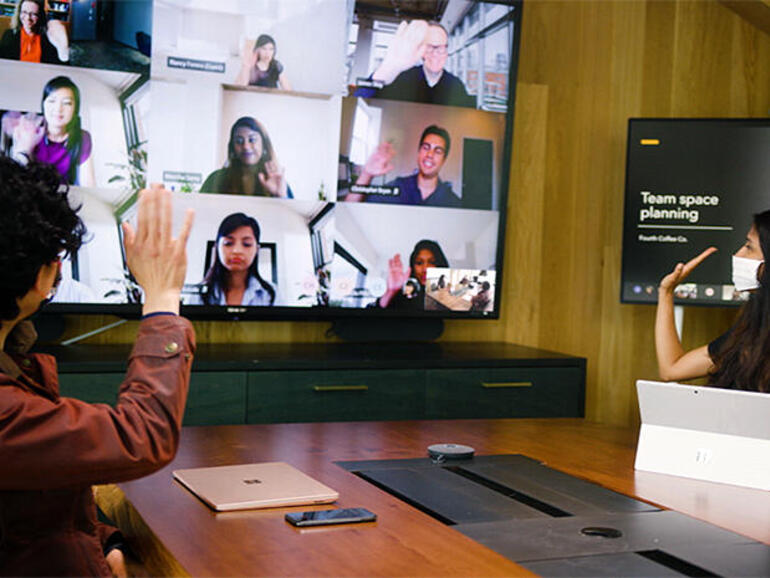The first annual Microsoft Work Trend Index should be a wake-up call for bosses and software developers alike to improve employee experiences as offices reopen.

Image: Microsoft
The majority of people want flexible remote work to continue, but new research from Microsoft warns leaders that they’re out of touch with exhausted employees and need to plan if hybrid work is to be successful. Otherwise, they will lose staff — especially Gen Z workers.
There have been plenty of smaller-scale studies showing how working habits, attitudes to remote work and plans for the future have changed during the pandemic, but the scale of Microsoft’s Work Trend Index — interviews with over 30,000 people across 31 countries, plus analysis of trillions of mails, messages, Teams meetings and other activity across Microsoft 365 and LinkedIn — lends it more weight.
Indeed, with the data representing “a global and cross-industry view on how work is changing”, Microsoft will be using it to guide product development and even reorganise some of its own offices, Kamal Janardhan, general manager of Microsoft 365 Insights told TechRepublic.
Remote trade-offs

Microsoft’s Kamal Janardhan: “The flexibility and agility is something that people appreciate, and it’s here to stay.”
Image: Microsoft
Obviously, remote work is a major topic. “The theme of the pandemic is that the entire world participated in this work-from-home experiment, and it became a norm essentially,” Janardhan said. “For a lot of people it used to be ‘can we even do that as an organisation?’ and now it’s the norm — of course we can.”
Although it varies by country, industry and what job you have, the interest in remote work is strong, despite the drawbacks. Nearly three-quarters (73%) of workers in the survey want the option of flexible remote work to continue, and 46% plan to move because of that flexibility.
“The flexibility and agility is something that people appreciate, and it’s here to stay,” Janardhan maintains. “This is going to be the new way of working [that] is actually going to [bring] better culture, more inclusion. The human need to accommodate each other is something that creates connection, and all of us should think about how we accommodate each other in this new way of working.”
The good news is that 40% of workers feel they can finally bring their full selves — complete with pets, family members and the worries they might share, along with a few tears — to work without embarrassment, the way employees have been promising they could all along. People who have those closer interactions report higher productivity as well as better wellbeing and stronger work relationships.
That’s much harder for Black and Latino workers in the US, Microsoft notes in the report: these groups find it slightly harder to build relationships with their team, feel less included and are less likely to feel they can be themselves.
But with lines between work and home blurring, we’ve lost what Janardhan calls “cognitive white space” — travelling to work or dropping children off at school might mean traffic jams, but it also provides a transition that the ‘virtual commute’ in Teams might not fully replicate.
Teams meetings last longer — 45 minutes rather than 35 the year before — and people are in more meetings, (with almost two-thirds of those not being scheduled in advance), adding up to 2.5x more time in meetings. They also send 45% more chat messages and do 42% more chats out of business hours. Despite all the pressures of the past year and the fact that remote work should allow for asynchronous work styles, people aren’t stepping away from work: just like the year before, 50% of people respond within five minutes in a Teams chat.
It’s not just Teams: 66% more people are creating documents that would presumably have been conversations before, and just among Exchange Online commercial and education customers, 40.6 billion more email messages were sent in February 2021 than in February 2020.
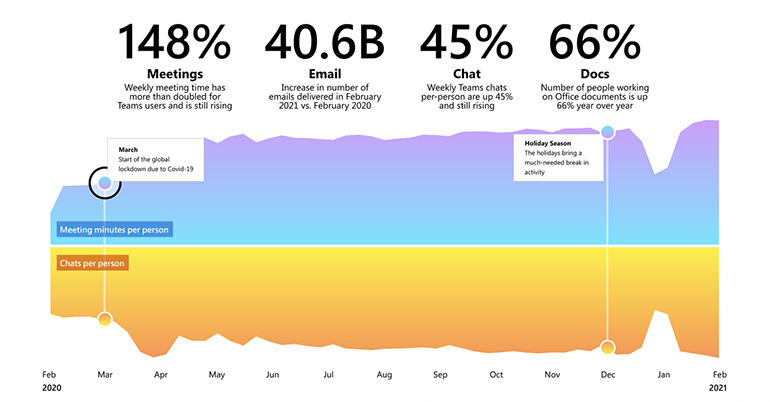
Image: Microsoft
Trying to make up for not being in the same room as people by spending so much the time in Teams interactions may be why 54% of people feel overworked and 39% are downright exhausted. Despite options like Together mode, the combination of the urgent feeling of virtual meetings and the lack of social cues and body language creates ‘digital static’ that makes it harder to communicate and understand what other people mean. That leads to fatigue, anxiety and even less of a feeling of connection.
We’re spending more time with those we work closely with, but much less time with the broader network of people. Messages in Teams channels that the whole group can see are down 5%, while private and small group chats are up 87%. Some of that back channel is positive — attempts to replicate those physical interactions, Janardhan suggests. “Previously it was rude to chat while you were in the meeting, and now it’s the norm, because this is how people exchange things that were previously available only through body language. I would lean over to the person next to me and say ‘really?’ or I would smile. Now we do that in the chat.”
Feeling included correlates with feeling productive and collaborating, coming up with new ideas and thinking strategically — the things that contribute to creativity and innovation, which are under threat. “Innovation is defined by the things that you create together as a community. This risk to innovation is caused by the fact that when we look at how people are interacting with each other, the level, the depth of their conversations, the time they spend, the team bonds and networks are diminishing,” Janardhan warns.
SEE: Brain hacks to boost productivity with music. Should you be listening to more ABBA? (TechRepublic)
Close-knit groups can be supportive, but they can also be silos of groupthink with no new ideas, Microsoft researcher Nancy Baym (who studies social connections) cautions in the report. “Bumping into people in the office and grabbing lunch together may seem unrelated to the success of the organization, but they’re actually important moments where people get to know one another and build social capital. They build trust, they discover common interests they didn’t know they had, and they spark ideas and conversations.”
It’s worst for Gen Z: 60% of 18-25s (who may be living alone or lack the space and money to create a good home workspace) say they’re surviving rather than thriving, or flat-out struggling. They find it harder to balance work and life, they’re more likely to feel exhausted after work, they don’t feel engaged because they can’t suggest new ideas or even get a chance to talk in meetings and they have fewer opportunities to make up for that and grow their career by networking because they can’t connect with people casually at work. “They feel like the outlook is worse than ever on feeling engaged and excited about work, career advancement, being included in conversations and meetings, wellbeing and productivity,” Janardhan notes.
Those downsides are why 67% of people want more in-person time with their colleagues as well as working remotely.
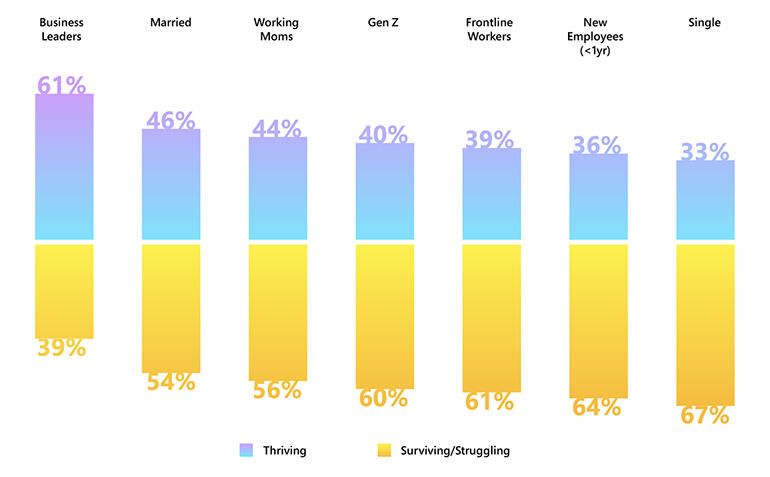
There’s a disconnect between how business leaders and various groups of employees are coping with remote working.
Image: Microsoft
Overoptimistic leaders
Even though two-thirds of employers talk about converting offices into hybrid work locations, they seem to be out of touch with how much this matters. Business leaders are mostly male, information workers and either Gen X or millennials and they’re thriving (61%, up over 20% from pre-pandemic), reporting better relationships with colleagues and their own bosses and taking all of their vacation days or even a few extras. “However, their employees are actually saying that they’re tired — the time spent in meetings has almost tripled, and it’s still increasing.”
Women, frontline workers, those with less career progress and especially Gen Z are struggling — and 37% of all staff say their company is asking too much of them. A fifth say their employer doesn’t care about their work-life balance.
“This dissonance between how leaders are seeing what’s happening and how individuals and teams are feeling is really key,” Janardhan warns.
One problem is that leaders are more isolated than before the pandemic. “What we see with leaders is that they’re often focused on talking to that core group a lot. Previously they had all-hands meetings or company parties: the large gathering is exactly what the pandemic took away from us, it’s something they no longer have access to so they become more siloed,” Janardhan explains.
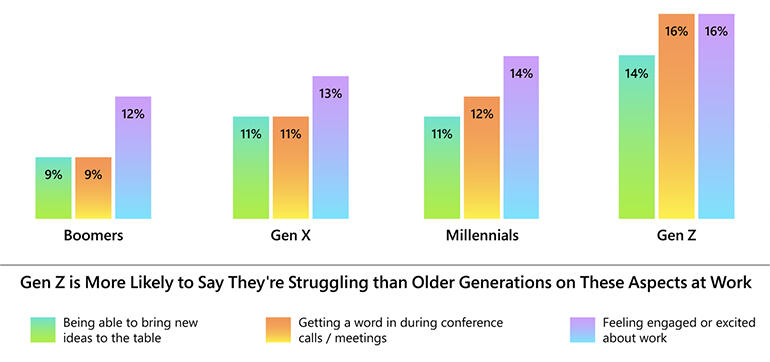
Image: Microsoft
Companies advertising more roles as remote work (a 5x increase in remote job postings on LinkedIn) aren’t always investing in what staff need to make that work: 42% of employees say they’re missing some ‘office essentials’ and one in ten say their internet connection at home isn’t good enough for their work. Worldwide, only 46% of staff get even a portion of remote work expenses paid.
Oblivious leaders may get a rude awakening. Remote flexibility and a lack of support may explain why 41% of employees are now planning to leave their current job within a year. “This is a pretty significant trend increase,” Janardhan notes. “When you look at Gen Z, the younger population that has been in the workforce for less time, that jumps to 54%. How leaders approach this next phase of work will impact who stays, who goes, and who joins the company, and it will significantly impact the bottom line. How do you manage your overall workforce with this churn and transition happening?”
Although Microsoft has some suggestions about using technology to improve the situation, most of the strategies the report suggests are about improving employee experience by being flexible and supportive — and setting the right example.
“This is a pivotal moment in history: we’re on the cusp of the next workforce disruption. Across the board companies are thinking about how they can reinvent themselves,” says Janardhan. “We should resist the urge to see this new way of working, hybrid work, as business-as-usual. It is an opportunity to rethink long-held assumptions, and I’m convinced that if we take the good that’s emerging from this time with us, then we’re going to reinvent for much better workforce [conditions].”
The cultural norms inside companies about hybrid work need to be matched with new thinking about workspaces, Janardhan says. “If entering a certain physical space or exiting it was how you defined working, that’s gone out the window. Organisations have all these cultures about ‘when did you badge and when did you badge out, how long did you work?’ That will have to evolve for this new type of working that is more individual, more empowered, more trusting, but also needs to have guardrails in place to be effective.”
SEE: Office 365: A guide for tech and business leaders (free PDF) (TechRepublic)
Both expectations and technology will need to change to make hybrid work successful, Janardhan suggests. “If you do back-to-back meetings because you have no need to commute from one place to another, you’re going to be exhausted. It was typical, when you walk to a meeting room, to visit the restroom or get a drink of water and have a conversation. If you eliminate that, that’s going to be the opposite of productive for every human being for every team. You can’t write the best document or the best code if you aren’t creating the right cognitive, critical space for deep work and collaboration work.”
The new Viva Insights tool can be helpful, Janardhan notes. “We’re finding people are eager to set things like ‘this is my focus time, this is my deep work time, this is my after-hours time’. That creates the courtesy culture you previously got from in-person interactions. I could see someone was heads-down, working at their desk, and I wouldn’t interrupt. Bringing that sort of human sense into Teams standards is a huge part of this.”
But combating the exhaustion of remote work doesn’t mean lecturing people about taking a break — it has to come from the top down. “You can’t have individuals saying ‘we should have protected after-hours time’ if you don’t have leaders creating the structure by saying ‘I will have certain times where I will engage and interact with the team and those will meet the guardrails and the norms of effective work/life scheduling’.”
If companies introduce extra wellness days (Microsoft has added five extra days of time off for employees), leaders need to show that it’s OK to use them by taking time off and encouraging staff to do the same. They should also encourage people to take time to network and connect, for fun as well as for work, because that’s not an unproductive distraction. “Embrace the asynchronous collaboration, create a culture of breaks and interaction space for human interaction versus just transactional,” says Janardhan.
“We’re human, we will always have to meet — we will just do it more intentionally on our own terms, with more flexibility,” she adds.
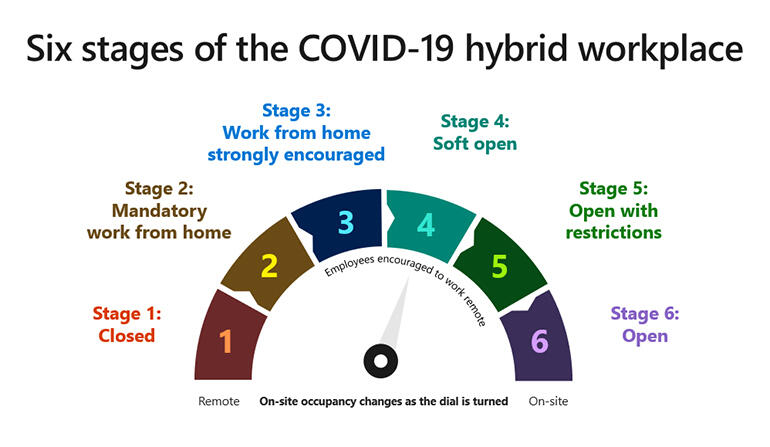
Image: Microsoft
Rebuilding the office
The culture change includes rethinking the spaces people work in, because while many employees want both face-to-face time and the opportunity to work remotely at least some of the time, they’re not positive about hybrid meetings. “Meetings where everyone’s online: everyone rated those as the most inclusive. Meetings where everyone’s in person are next, and the meetings with some online and some in person were the least inclusive,” Janardhan tells TechRepublic.
“Physical spaces have often been just a holding ground for people to get transactional work done. If you create rich collaboration — for example extending the whiteboarding capabilities in Teams to a physical space — you get a very different kind of physical space.”
Microsoft already has about 20% of its global employees back in offices and other locations in 21 countries, and plans to slowly reopen its Redmond headquarters to staff from March 29. Last year the company said that in the long run it will be standard for employees whose job doesn’t need them to be in a specific location like a data centre or a hardware lab to work remotely up to 50% of the time if they want. That’s already common for some groups like Azure DevOps, which has team members in several different countries, but a much bigger shift for teams like Windows, which has traditionally required employees to move to Seattle. For now, though, employees working in and near Redmond will be able to choose if they want to return to the office, carry on working remotely, or combine the two.
SEE: COVID-19 workplace policy (TechRepublic Premium)
Previously, the campus has been at stage three of Microsoft’s hybrid workplace classing, with working from home strongly encouraged. On March 29 it shifts to stage four, a soft opening. “Employees are encouraged to work remotely” a letter from executive vice president Kurt DelBene says. They “should not feel they need to return” but can “work where they feel most productive and comfortable”. Precautions on campus will include “social distancing of workspaces, face coverings, extensive cleaning procedures, daily health attestations, attendance strategies and more”.
In other Microsoft locations at stage four, less than a third of employees are in the office for half of their working week and more than half are only there 25% of the time. If conditions worsen, the dial could shift back to a more restrictive level and Microsoft won’t remove those measures until COVID-19 is more like a seasonal flu than a pandemic.
The company is also building prototype hybrid meeting spaces in Redmond and its UK offices, experimenting with multiple screens, cameras and mixed reality scenarios to try and make meetings equally inclusive for remote workers and people in the room. That might look like the spacious offices Microsoft has shown in the Viva launch video, with a curved row of tables and wall-sized screens with a filmstrip view of remote attendees that puts everyone face to face, or something more like Microsoft Mesh mixed reality. Either way, offices and meeting rooms will need to be appealing spaces that are more attractive than staying home.
Software will be an important part of this, because it can help create habits and culture as well as simply enabling report work, and Janardhan is keen to see technology that better supports people. “My hope is that we and absolutely every single software company start thinking about the reinvention of employee experience. This is the rising tide that should raise all ships: we should change the way we think about software and service of that human endeavour.”
Also see
This article is auto-generated by Algorithm Source: www.techrepublic.com

